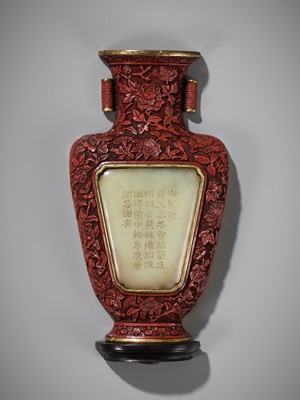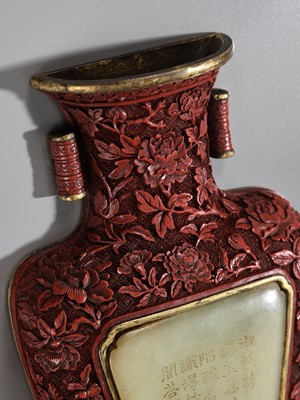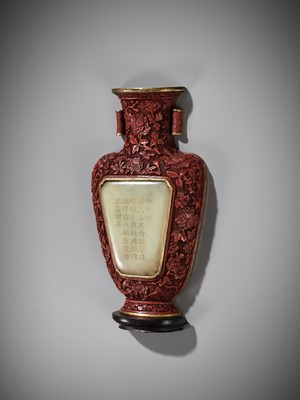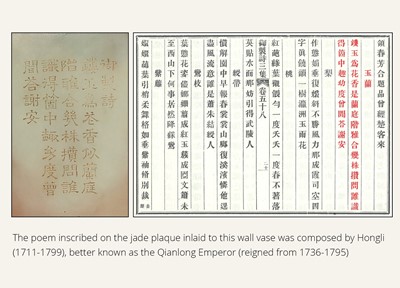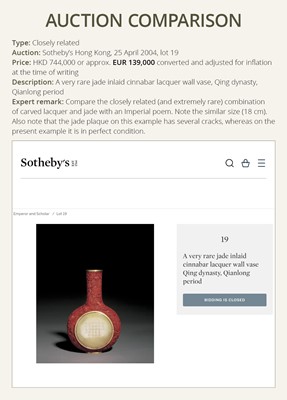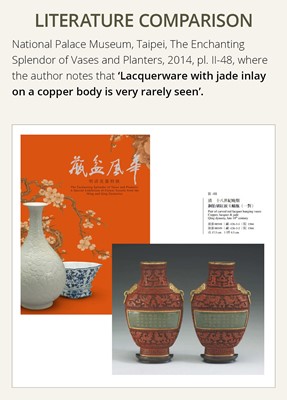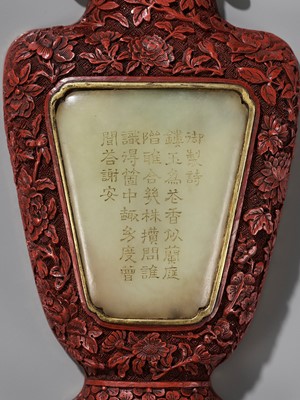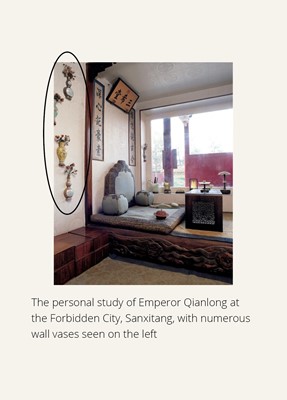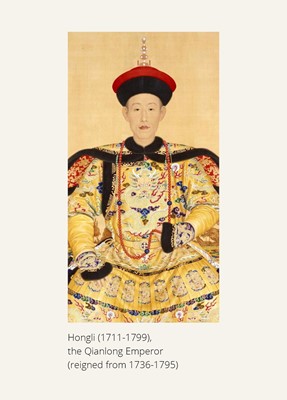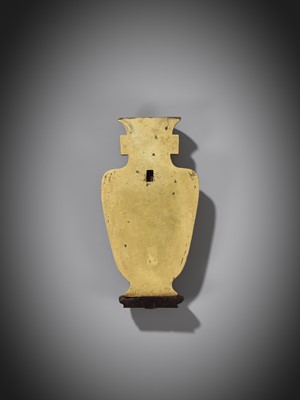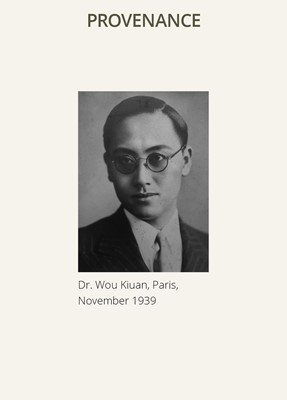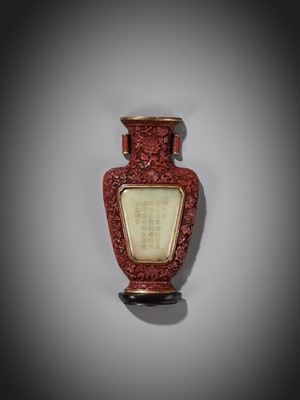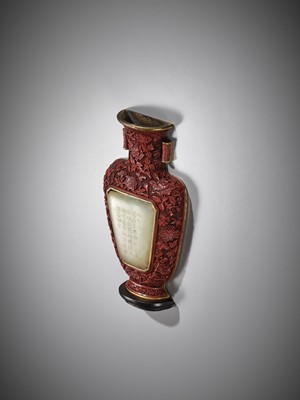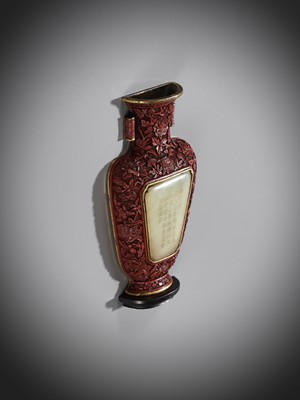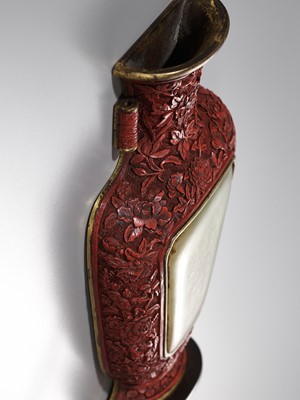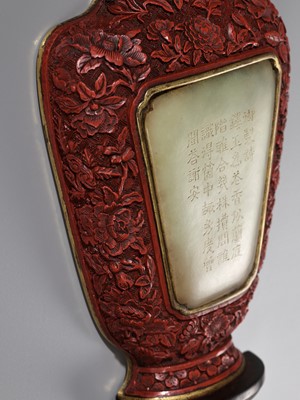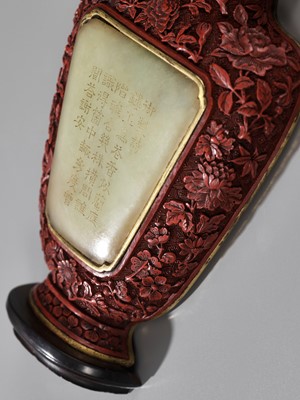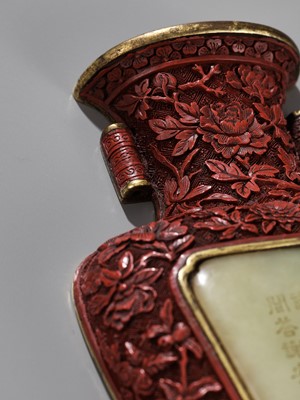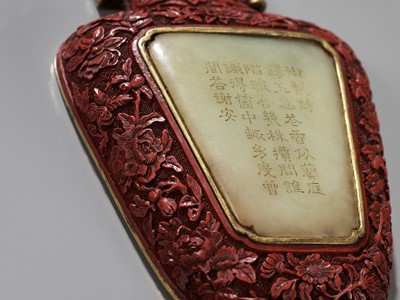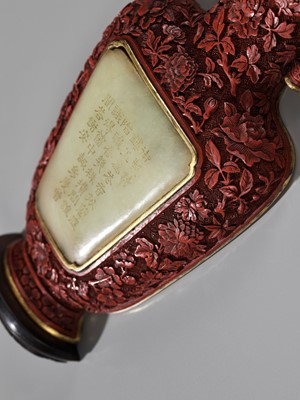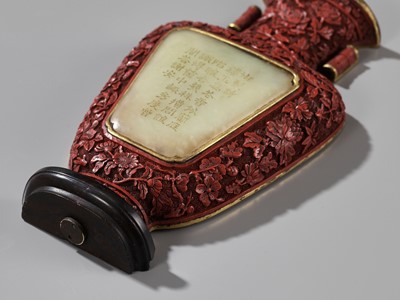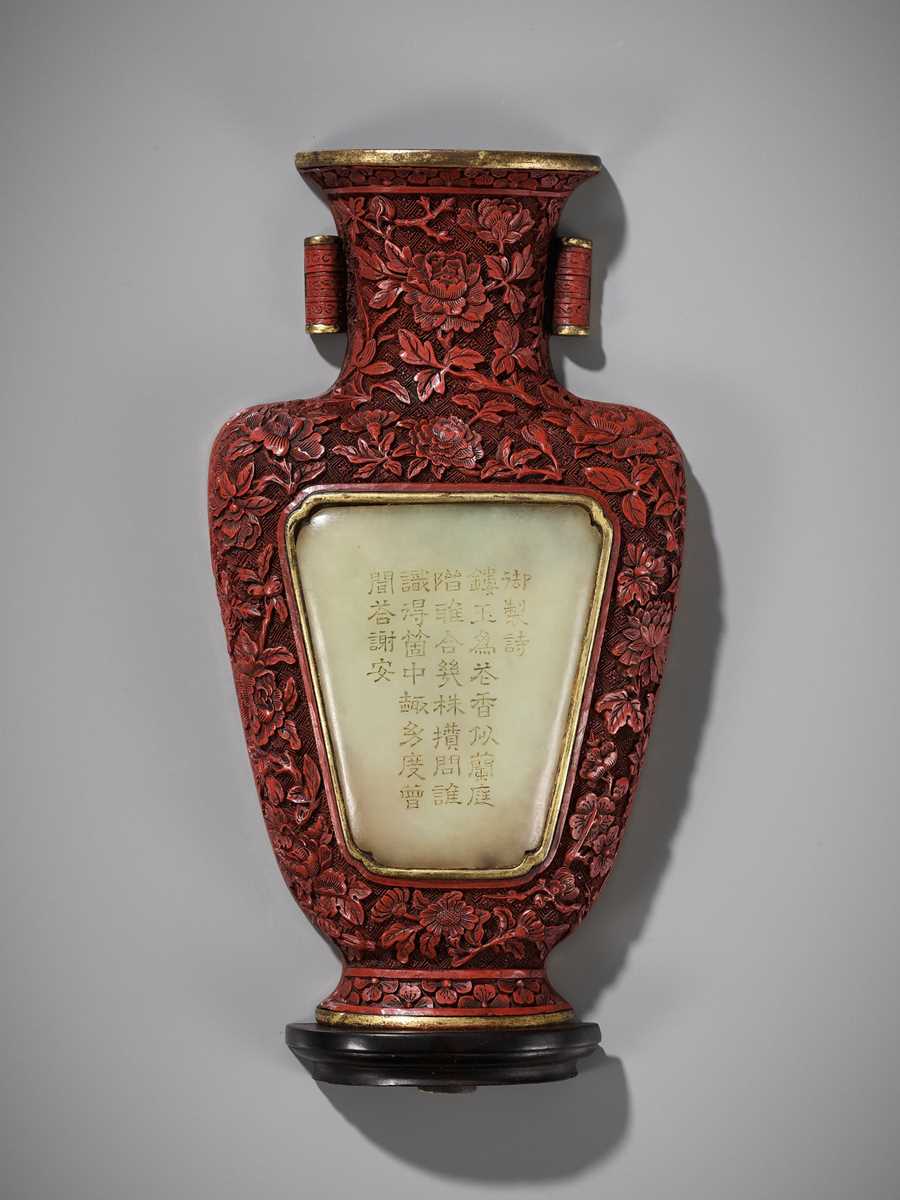9th Mar, 2023 13:00
TWO-DAY AUCTION - Fine Chinese Art / 中國藝術集珍 / Buddhism & Hinduism
7
AN IMPERIAL JADE-INLAID CINNABAR LACQUER WALL VASE INSCRIBED WITH A POEM BY HONGLI (1711-1799), QIANLONG PERIOD
乾隆時期御製剔犀鑲玉刻御詩壁瓶
Sold for €97,500
including Buyer's Premium
The poem inscribed on the jade plaque was composed by Hongli (1711-1799), better known as the Qianlong Emperor (reigned from 1736-1795). It is recorded in Qing Gaozong yuzhi shiwen quanji (Anthology of Imperial Qianlong Poems and Texts), volume 3, juan 58, page 19, figure 1, and can be translated as follows:
Jade carved into flowers are fragrant like orchids,
Between the garden steps, a few are elegantly planted.
Who knows their essential beauty?
Youdu, once asked this, answered with "Xie An".
China, 1736-1795. Finely cast from gilt-bronze into baluster form flattened on one plane, mounted on the body with a shaped yellowish-celadon jade plaque inscribed in clerical script with a thirty-one-character Imperial poem, all surrounded by superbly carved blossoms of peony, chrysanthemum, and prunus borne on leafy branches against a diaper ground, framed by bands of prunus blossoms below the neck and above the foot, the neck flanked by two short tubular handles incised with scroll.
Provenance: From the collection of Dr. Wou Kiuan. Wou Lien-Pai Museum, coll. no. Q.J.111. Dr. Wou Kiuan (1910-1997) was a Chinese diplomat and noted scholar of Chinese art. His father, Wou Lien-Pai (1873-1944), was one the leading political figures of early 20th century China, remembered for his role as speaker and leader of parliament during the turbulent years of the Republican era. Dr. Wou himself embarked on an illustrious career in diplomacy until his retirement in 1952, when he settled in London and devoted the rest of his life to the study of Chinese art. It was no doubt fortuitous that Dr. Wou’s years of collecting coincided with an abundant availability of exceptional Chinese art on the London market. From the mid-1950s to the late 1960s he was able to form a collection of well over 1,000 works that together represented virtually every category of Chinese art. At the heart of Dr. Wou’s drive to collect was a burning desire to preserve the relics of China’s rich historical past scattered across Europe, and to promote Chinese art and culture. It is unclear when Dr. Wou conceived of the idea to create a place to house his collection, but in 1968 he opened the doors to the Wou Lien-Pai Museum, named in honor of his father. Over the years the Museum became a ‘must see’ destination for collectors, academics, and visiting dignitaries, and Dr. Wou would delight in leading his visitors through the galleries, recounting stories of China’s glorious history.
Condition: Superb condition with expected minor wear, few minuscule nicks, the back with light surface scratches, the wood base with a small chip. Fine, naturally grown patina overall.
Weight: 512.2 g
Dimensions: Height 18.6 cm
Mounted on a short wood base, probably zitan and dating from the same period. (2)
Hongli was the fourth son of Yongzheng and born to Noble Consort Xi. He was adored by his grandfather, the Kangxi Emperor, and some historians argue to this day that Kangxi appointed Yongzheng as his successor only because Hongli was his favorite grandson. One of China’s eternal visionaries, Kangxi is said to have spotted the singular leadership talent of the later Emperor Qianlong in Hongli when he was still a child. In 1796, the Qianlong Emperor abdicated in favor of his son, the Jiaqing Emperor, in a filial act so as not to reign longer than his grandfather, the Kangxi Emperor, who ruled for 61 years. Despite his retirement, he retained ultimate power as the Emperor Emeritus until his death in 1799, making him one of the longest-reigning monarchs in history, and, dying at the age of 87, one of the longest-lived. As a capable and cultured ruler inheriting a thriving empire, during his long reign, the Qing Empire reached its most splendid and prosperous era, boasting a large population and economy.
Wall vases were particularly popular during the reign of Qianlong and are known to have adorned the walls of the Sanxitang (The Hall of Three Rarities), a tiny studio next to the Imperial bedchamber in the Yangxindian. They were produced in a variety of materials, including porcelain, cloisonne enamel and lacquer, and occasionally inscribed with poems by the Emperor himself, such as the present lot. Compare several porcelain wall vases in the collection of the Palace Museum Beijing, illustrated in The Life of Emperor Qianlong, The Macau Museum of Art, Macau, 2002, cat. nos. 63-2 to 63-9. The present wall vase ranks among the most unusual and rarest examples produced during the Qianlong reign, as it combines gilt-bronze, cinnabar lacquer and carved jade.
Expert’s note: Carved cinnabar lacquer and gilt-bronze wall vases combined with jade inlays are very rare. The examples that come up for auction now and then almost invariably have condition issues such as strong wear to the gilding, losses and cracks to the lacquer, cracks or - worse - replacements to the jade inlays, and others. The pristine condition of the present wall vase makes it not just exceptionally rare, but literally unique.
Literature comparison:
Compare a pair of wall vases in the National Palace Museum, Taipei, included in the museum's exhibition The Enchanting Splendor of Vases and Planters: A Special Exhibition of Flower Vessels from the Ming and Qing Dynasties, 2014, pl. II-48 (fig. 1), where the author notes that ‘Lacquerware with jade inlay on a copper body is very rarely seen’.
Also compare two boxes, one rectangular, the other chime-shaped, both inset with jade plaques, in the Palace Museum Beijing, illustrated in Carved Lacquer in the Collection of the Palace Museum, Beijing, 1964, cat. nos. 313 and 315. Compare a jade plaque inset in a cinnabar lacquer moon flask, similarly incised with a Qianlong seal mark and of the period, at Christie’s Hong Kong, 27 April 1997, lot 21.
Auction result comparison:
Type: Closely related
Auction: Sotheby’s Hong Kong, 25 April 2004, lot 19
Price: HKD 744,000 or approx. EUR 139,000 converted and adjusted for inflation at the time of writing
Description: A very rare jade inlaid cinnabar lacquer wall vase, Qing dynasty, Qianlong period
Expert remark: Compare the closely related (and extremely rare) combination of carved lacquer and jade with an Imperial poem. Note the similar size (18 cm). Also note that the jade plaque on this example has several cracks, whereas on the present example it is in perfect condition.
乾隆時期御製剔犀鑲玉刻御詩壁瓶
中國,1736-1795年。鑲鎏金銅,剔犀掛瓶,頸部左右分別有一貫耳。瓶身錦地纏枝花卉紋,瓶身中央鑲嵌玉牌,上雕刻一首御詩。
御製詩:鏤玉為蒼香似蘭,庭階聼合幾株攢。問誰識得個中趣,幾度曾聞答謝安。
為乾隆帝(1711-1799) 御詩,收錄於《清高宗御製詩文全集》,第三冊,卷58,第19頁,圖 1。
來源:吳權博士收藏;吳蓮伯美術館,館藏編號 Q.J.111。吳權(1910-1997)博士 曾是一位中國外交家以及知名中國藝術收藏家。他的父親吳蓮伯 (1873-1944)先生曾是二十世紀初中國重要政治人物,因在民國動蕩歲月中擔任國會議員及議長而聞名。1952 年,吳博士在外交領域走上了輝煌之路,直到他退休後定居倫敦,並將餘生奉獻給了對中國藝術的研究。毫無疑問,吳權博士多年的收藏,與大量中國藝術珍品現身倫敦藝術市場上時間點相呼應,這無疑是幸運的。從 1950 年代中期到 1960 年代後期,他收集了 1,000 多件藏品,涵蓋了中國藝術的每一個門類。吳博士之所以收藏,其原因主要是爲保護散落歐洲各地的中國文物與推廣中國藝術與文化。尚不清楚吳博士何時想到創建一個美術館來歸置他的收藏的,但在 1968 年,他打開了以他父親的名字命名的 吳蓮伯美術館的大門。多年來,美術館已成為收藏家、學者和來訪政要的必經之地,而吳博士總是很樂意給參觀者介紹美術館,講述中國光輝歷史的故事。
品相:狀況極佳,有輕微磨損,微小刻痕,背面有輕微的劃痕,木底座有小缺口。整體呈精細、自然的包漿。
重量:512.2克
尺寸:高 18.6 厘米
木底座,可能為同期紫檀。(2)
壁瓶在乾隆年間尤為流行。眾所周知,三希堂内也有壁瓶。它們由各種材料製成,包括瓷器、景泰藍和漆器,偶爾還會刻有御詩,例如本拍品。比較北京故宮博物院收藏的幾件瓷壁瓶,插圖見《The Life of Emperor Qianlong》,澳門藝術博物館,澳門,2002年,編號 1,63-2 至 63-9。本壁瓶堪稱乾隆年間最稀有珍品。
專家注釋:剔犀嵌玉壁瓶極為罕見,出現在拍賣會上的幾乎總是存在狀況問題,本壁花瓶完好無損,極其稀有。
文獻比較:
比較一件一對壁瓶,收藏於臺北故宮博物院,展覽於《The Enchanting Splendor of Vases and Planters: A Special Exhibition of Flower Vessels from the Ming and Qing Dynasties》,2014年,圖II-48。作者在書中描寫:「銅胎嵌玉漆器極為罕見!」比較兩件嵌玉壁瓶,一件長方形、一件鐘形,收藏於北京故宮博物院,見《Carved Lacquer in the Collection of the Palace Museum》,北京,1964年,圖錄編號313和315。比較一件剔犀內嵌玉匾月瓶,相似的乾隆款識,售於香港佳士得,1997年4月27日,lot 21。
拍賣結果比較:
形制:非常相近
拍賣:香港蘇富比,2004年4月25日,lot 19
價格:HKD 744,000(相當於今日EUR 139,000)
描述:乾隆剔犀嵌玉璧瓶
專家評論:比較非常相近 (以及極罕見) 的剔犀雕刻嵌玉、題玉詩。請注意相似的尺寸(18 厘米)。請注意此內嵌玉牌有數道裂痕,品項較我們的拍品差。
#byimperialcommand
#worksofart
The poem inscribed on the jade plaque was composed by Hongli (1711-1799), better known as the Qianlong Emperor (reigned from 1736-1795). It is recorded in Qing Gaozong yuzhi shiwen quanji (Anthology of Imperial Qianlong Poems and Texts), volume 3, juan 58, page 19, figure 1, and can be translated as follows:
Jade carved into flowers are fragrant like orchids,
Between the garden steps, a few are elegantly planted.
Who knows their essential beauty?
Youdu, once asked this, answered with "Xie An".
China, 1736-1795. Finely cast from gilt-bronze into baluster form flattened on one plane, mounted on the body with a shaped yellowish-celadon jade plaque inscribed in clerical script with a thirty-one-character Imperial poem, all surrounded by superbly carved blossoms of peony, chrysanthemum, and prunus borne on leafy branches against a diaper ground, framed by bands of prunus blossoms below the neck and above the foot, the neck flanked by two short tubular handles incised with scroll.
Provenance: From the collection of Dr. Wou Kiuan. Wou Lien-Pai Museum, coll. no. Q.J.111. Dr. Wou Kiuan (1910-1997) was a Chinese diplomat and noted scholar of Chinese art. His father, Wou Lien-Pai (1873-1944), was one the leading political figures of early 20th century China, remembered for his role as speaker and leader of parliament during the turbulent years of the Republican era. Dr. Wou himself embarked on an illustrious career in diplomacy until his retirement in 1952, when he settled in London and devoted the rest of his life to the study of Chinese art. It was no doubt fortuitous that Dr. Wou’s years of collecting coincided with an abundant availability of exceptional Chinese art on the London market. From the mid-1950s to the late 1960s he was able to form a collection of well over 1,000 works that together represented virtually every category of Chinese art. At the heart of Dr. Wou’s drive to collect was a burning desire to preserve the relics of China’s rich historical past scattered across Europe, and to promote Chinese art and culture. It is unclear when Dr. Wou conceived of the idea to create a place to house his collection, but in 1968 he opened the doors to the Wou Lien-Pai Museum, named in honor of his father. Over the years the Museum became a ‘must see’ destination for collectors, academics, and visiting dignitaries, and Dr. Wou would delight in leading his visitors through the galleries, recounting stories of China’s glorious history.
Condition: Superb condition with expected minor wear, few minuscule nicks, the back with light surface scratches, the wood base with a small chip. Fine, naturally grown patina overall.
Weight: 512.2 g
Dimensions: Height 18.6 cm
Mounted on a short wood base, probably zitan and dating from the same period. (2)
Hongli was the fourth son of Yongzheng and born to Noble Consort Xi. He was adored by his grandfather, the Kangxi Emperor, and some historians argue to this day that Kangxi appointed Yongzheng as his successor only because Hongli was his favorite grandson. One of China’s eternal visionaries, Kangxi is said to have spotted the singular leadership talent of the later Emperor Qianlong in Hongli when he was still a child. In 1796, the Qianlong Emperor abdicated in favor of his son, the Jiaqing Emperor, in a filial act so as not to reign longer than his grandfather, the Kangxi Emperor, who ruled for 61 years. Despite his retirement, he retained ultimate power as the Emperor Emeritus until his death in 1799, making him one of the longest-reigning monarchs in history, and, dying at the age of 87, one of the longest-lived. As a capable and cultured ruler inheriting a thriving empire, during his long reign, the Qing Empire reached its most splendid and prosperous era, boasting a large population and economy.
Wall vases were particularly popular during the reign of Qianlong and are known to have adorned the walls of the Sanxitang (The Hall of Three Rarities), a tiny studio next to the Imperial bedchamber in the Yangxindian. They were produced in a variety of materials, including porcelain, cloisonne enamel and lacquer, and occasionally inscribed with poems by the Emperor himself, such as the present lot. Compare several porcelain wall vases in the collection of the Palace Museum Beijing, illustrated in The Life of Emperor Qianlong, The Macau Museum of Art, Macau, 2002, cat. nos. 63-2 to 63-9. The present wall vase ranks among the most unusual and rarest examples produced during the Qianlong reign, as it combines gilt-bronze, cinnabar lacquer and carved jade.
Expert’s note: Carved cinnabar lacquer and gilt-bronze wall vases combined with jade inlays are very rare. The examples that come up for auction now and then almost invariably have condition issues such as strong wear to the gilding, losses and cracks to the lacquer, cracks or - worse - replacements to the jade inlays, and others. The pristine condition of the present wall vase makes it not just exceptionally rare, but literally unique.
Literature comparison:
Compare a pair of wall vases in the National Palace Museum, Taipei, included in the museum's exhibition The Enchanting Splendor of Vases and Planters: A Special Exhibition of Flower Vessels from the Ming and Qing Dynasties, 2014, pl. II-48 (fig. 1), where the author notes that ‘Lacquerware with jade inlay on a copper body is very rarely seen’.
Also compare two boxes, one rectangular, the other chime-shaped, both inset with jade plaques, in the Palace Museum Beijing, illustrated in Carved Lacquer in the Collection of the Palace Museum, Beijing, 1964, cat. nos. 313 and 315. Compare a jade plaque inset in a cinnabar lacquer moon flask, similarly incised with a Qianlong seal mark and of the period, at Christie’s Hong Kong, 27 April 1997, lot 21.
Auction result comparison:
Type: Closely related
Auction: Sotheby’s Hong Kong, 25 April 2004, lot 19
Price: HKD 744,000 or approx. EUR 139,000 converted and adjusted for inflation at the time of writing
Description: A very rare jade inlaid cinnabar lacquer wall vase, Qing dynasty, Qianlong period
Expert remark: Compare the closely related (and extremely rare) combination of carved lacquer and jade with an Imperial poem. Note the similar size (18 cm). Also note that the jade plaque on this example has several cracks, whereas on the present example it is in perfect condition.
乾隆時期御製剔犀鑲玉刻御詩壁瓶
中國,1736-1795年。鑲鎏金銅,剔犀掛瓶,頸部左右分別有一貫耳。瓶身錦地纏枝花卉紋,瓶身中央鑲嵌玉牌,上雕刻一首御詩。
御製詩:鏤玉為蒼香似蘭,庭階聼合幾株攢。問誰識得個中趣,幾度曾聞答謝安。
為乾隆帝(1711-1799) 御詩,收錄於《清高宗御製詩文全集》,第三冊,卷58,第19頁,圖 1。
來源:吳權博士收藏;吳蓮伯美術館,館藏編號 Q.J.111。吳權(1910-1997)博士 曾是一位中國外交家以及知名中國藝術收藏家。他的父親吳蓮伯 (1873-1944)先生曾是二十世紀初中國重要政治人物,因在民國動蕩歲月中擔任國會議員及議長而聞名。1952 年,吳博士在外交領域走上了輝煌之路,直到他退休後定居倫敦,並將餘生奉獻給了對中國藝術的研究。毫無疑問,吳權博士多年的收藏,與大量中國藝術珍品現身倫敦藝術市場上時間點相呼應,這無疑是幸運的。從 1950 年代中期到 1960 年代後期,他收集了 1,000 多件藏品,涵蓋了中國藝術的每一個門類。吳博士之所以收藏,其原因主要是爲保護散落歐洲各地的中國文物與推廣中國藝術與文化。尚不清楚吳博士何時想到創建一個美術館來歸置他的收藏的,但在 1968 年,他打開了以他父親的名字命名的 吳蓮伯美術館的大門。多年來,美術館已成為收藏家、學者和來訪政要的必經之地,而吳博士總是很樂意給參觀者介紹美術館,講述中國光輝歷史的故事。
品相:狀況極佳,有輕微磨損,微小刻痕,背面有輕微的劃痕,木底座有小缺口。整體呈精細、自然的包漿。
重量:512.2克
尺寸:高 18.6 厘米
木底座,可能為同期紫檀。(2)
壁瓶在乾隆年間尤為流行。眾所周知,三希堂内也有壁瓶。它們由各種材料製成,包括瓷器、景泰藍和漆器,偶爾還會刻有御詩,例如本拍品。比較北京故宮博物院收藏的幾件瓷壁瓶,插圖見《The Life of Emperor Qianlong》,澳門藝術博物館,澳門,2002年,編號 1,63-2 至 63-9。本壁瓶堪稱乾隆年間最稀有珍品。
專家注釋:剔犀嵌玉壁瓶極為罕見,出現在拍賣會上的幾乎總是存在狀況問題,本壁花瓶完好無損,極其稀有。
文獻比較:
比較一件一對壁瓶,收藏於臺北故宮博物院,展覽於《The Enchanting Splendor of Vases and Planters: A Special Exhibition of Flower Vessels from the Ming and Qing Dynasties》,2014年,圖II-48。作者在書中描寫:「銅胎嵌玉漆器極為罕見!」比較兩件嵌玉壁瓶,一件長方形、一件鐘形,收藏於北京故宮博物院,見《Carved Lacquer in the Collection of the Palace Museum》,北京,1964年,圖錄編號313和315。比較一件剔犀內嵌玉匾月瓶,相似的乾隆款識,售於香港佳士得,1997年4月27日,lot 21。
拍賣結果比較:
形制:非常相近
拍賣:香港蘇富比,2004年4月25日,lot 19
價格:HKD 744,000(相當於今日EUR 139,000)
描述:乾隆剔犀嵌玉璧瓶
專家評論:比較非常相近 (以及極罕見) 的剔犀雕刻嵌玉、題玉詩。請注意相似的尺寸(18 厘米)。請注意此內嵌玉牌有數道裂痕,品項較我們的拍品差。
#byimperialcommand
#worksofart
Zacke Live Online Bidding
Our online bidding platform makes it easier than ever to bid in our auctions! When you bid through our website, you can take advantage of our premium buyer's terms without incurring any additional online bidding surcharges.
To bid live online, you'll need to create an online account. Once your account is created and your identity is verified, you can register to bid in an auction up to 12 hours before the auction begins.
Intended Spend and Bid Limits
When you register to bid in an online auction, you will need to share your intended maximum spending budget for the auction. We will then review your intended spend and set a bid limit for you. Once you have pre-registered for a live online auction, you can see your intended spend and bid limit by going to 'Account Settings' and clicking on 'Live Bidding Registrations'.
Your bid limit will be the maximum amount you can bid during the auction. Your bid limit is for the hammer price and is not affected by the buyer’s premium and VAT. For example, if you have a bid limit of €1,000 and place two winning bids for €300 and €200, then you will only be able to bid €500 for the rest of the auction. If you try to place a bid that is higher than €500, you will not be able to do so.
Online Absentee and Telephone Bids
You can now leave absentee and telephone bids on our website!
Absentee Bidding
Once you've created an account and your identity is verified, you can leave your absentee bid directly on the lot page. We will contact you when your bids have been confirmed.
Telephone Bidding
Once you've created an account and your identity is verified, you can leave telephone bids online. We will contact you when your bids have been confirmed.
Classic Absentee and Telephone Bidding Form
You can still submit absentee and telephone bids by email or fax if you prefer. Simply fill out the Absentee Bidding/Telephone bidding form and return it to us by email at office@zacke.at or by fax at +43 (1) 532 04 52 20. You can download the PDF from our Upcoming Auctions page.
How-To Guides
How to Create Your Personal Zacke Account
How to Register to Bid on Zacke Live
How to Leave Absentee Bids Online
How to Leave Telephone Bids Online
中文版本的操作指南
创建新账号
注册Zacke Live在线直播竞拍(免平台费)
缺席投标和电话投标
Third-Party Bidding
We partner with best-in-class third-party partners to make it easy for you to bid online in the channel of your choice. Please note that if you bid with one of our third-party online partners, then there will be a live bidding surcharge on top of your final purchase price. You can find all of our fees here. Here's a full list of our third-party partners:
- 51 Bid Live
- EpaiLive
- ArtFoxLive
- Invaluable
- LiveAuctioneers
- the-saleroom
- lot-tissimo
- Drouot
Please note that we place different auctions on different platforms. For example, in general, we only place Chinese art auctions on 51 Bid Live.
Bidding in Person
You must register to bid in person and will be assigned a paddle at the auction. Please contact us at office@zacke.at or +43 (1) 532 04 52 for the latest local health and safety guidelines.
